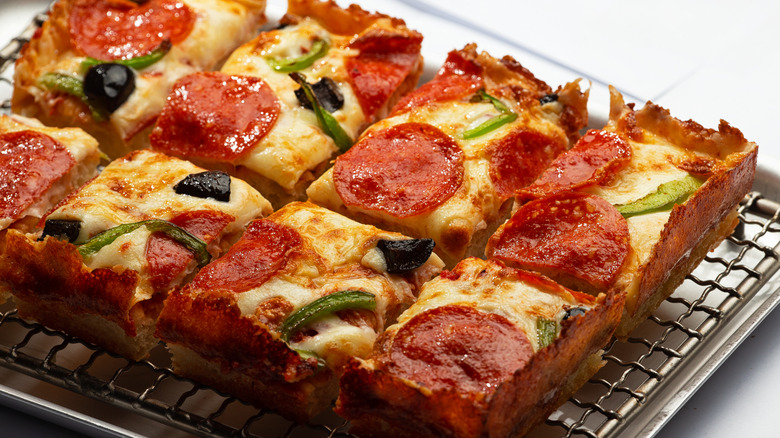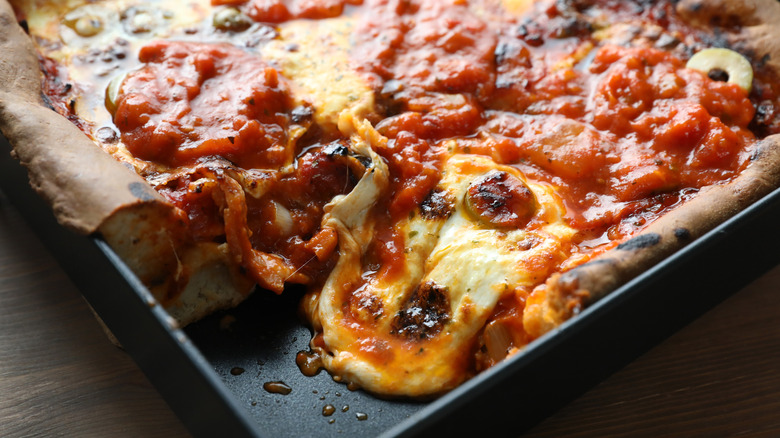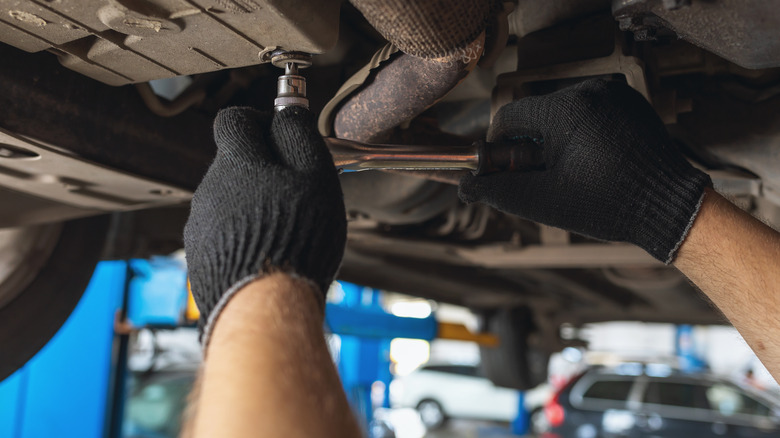The Specialized Pan That Gives Detroit-Style Pizza Its Signature Crunch
Detroit-style pizza may be made out of the same ingredients as other pizzas, but it has a few key differences. It has a crispy, caramelized crust, topped with little cups of pepperoni that have curled into tiny meaty bowls of oil. But the first thing you would probably notice about Detroit-style pizza is that it's rectangular instead of round.
Now, we know what you're thinking. Rectangular pizza isn't exactly anything ground-breaking in the world of pizza, especially if you consider pizzas like Old Forge-style pies are also rectangular in shape. While it's true that square-shaped pizza won't make any headlines for how unconventional it is, it's what gives the pizza its shape to begin with that's so important. You see, Detroit-style pizza isn't prepared in any ordinary pizza pan — instead, it's commonly prepared in a pan usually made out of steel or anodized aluminum. The pan is usually 10 inches by 14 inches with a depth of 2.5 inches, allowing for the pizza to develop that classic deep-dish taste and that lightly charred, caramelized flavor.
But what is so special about a pan made out of steel or anodized aluminum? Couldn't you just make Detroit-style pizza in something like a glass pan instead of shelling out for one very specific pan? Although it may seem cosmetic at first, the material the pan is made of is key to success.
The metal is a great conductor of heat
When you're looking for a baking tray or baking dish, you'll want something that can efficiently retain heat. if you're making a casserole or cookies, for example, you'll look for something that is a great conductor of heat, so that the food within the dish or on the tray can cook faster and more evenly. This same principle of retaining as much heat as possible applies to how Detroit pizzamakers prepare their pies and their reliance on metal pizza pans.
Aluminum and steel are widely used as materials for Detroit pizza pans, as both of them can withstand the high temperatures needed to achieve the trademark crispiness of the pizza. Yet it's important to note that both materials do differ slightly and excel in some aspects while lacking in others. Aluminum pans, for example, would have to be either heavier or anodized to avoid cracking or warping in extreme heat, yet are also much cheaper than steel pans and can have a nonstick coating. Steel pans, on the other hand, are somewhat more expensive but are perfect conductors of heat, especially around the bottoms and sides of the pizza, which will be cooked until a deep golden brown.
You can use a glass pan to prepare Detroit-style pizza if an anodized aluminum or steel pan isn't available to you. While the pizza will still come out good, it may not have the charred, crunchy exterior that the pizza is famously known for.
The original pans were used for automotive work
Why exactly did Detroit adopt the use of steel pans in their pizza-making? They could have just as easily made do with other trays or pans, couldn't they? The answer to the question doesn't start in a kitchen, but instead in the many garages, auto shops, and car factories that Detroit was so famously known for.
In the 1930s and 1940s, these deep and heavy "blue steel" pans were used mainly for utility, serving to collect waste oil, grease drippings, and other various types of fluids that came out of the automotive shops and assembly plants. As the story goes, the owner of Buddy's Pizza, Gus Guerra, was searching for a good pizza pan for a deep-dish Sicilian pizza. Guerra noticed that these blue steel drip pans were the perfect size and shape to make the pizza he was dreaming of. Not only did the shape of the dish form a perfect deep-dish pizza, but the blue steel provided a delicious char to the cheese and crust.
While blue steel pizza pans aren't as common as they were in the 1930s or 1940s by lack of the assembly plants Detroit once boasted, it's not uncommon to find someone selling what they call an "authentic" Detroit pizza pan (with some even supposedly dating back to the 1940s!) online. But, even if you don't have a classic blue steel pizza pan, a modern-day steel or aluminum pan works just as well.


